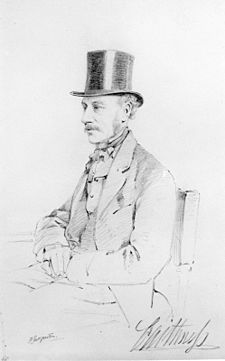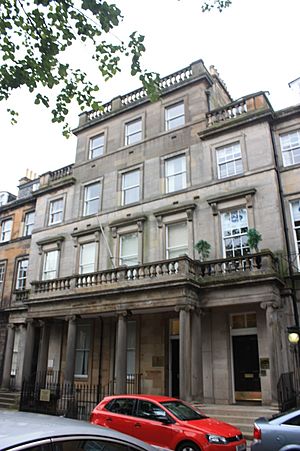James Sinclair, 14th Earl of Caithness facts for kids
James Sinclair, 14th Earl of Caithness (born August 16, 1821 – died March 28, 1881) was a Scottish nobleman. He was also a talented scientist and inventor. Besides his scientific work, he was a Liberal politician. He was known as Lord Berriedale before he became the Earl of Caithness in 1855.
Contents
Life of a Scottish Earl
James Sinclair became the 14th Earl of Caithness in 1855. This happened after his father, Alexander Sinclair, the 13th Earl, passed away.
Serving the Queen and Country
The Earl of Caithness held several important roles. He was a Vice-Admiral for the area of Caithness in Scotland. He also served Queen Victoria as a Lord-in-waiting. This meant he was an official who helped the Queen. He held this position from 1856 to 1858 and again from 1859 to 1866.
He even tutored Edward, the Prince of Wales, who later became Edward VII. This was a very important job.
In 1866, Queen Victoria gave him a new title: Baron Barrogill. This title was named after Castle of Mey, which was then called Barrogill Castle. This special title meant he automatically had a seat in the House of Lords. The House of Lords is part of the British Parliament. He had already been a Scottish Representative Peer there since 1858. He served in the government under Prime Ministers Lord Palmerston and Lord Russell.
From 1856 to 1881, he was the Lord-Lieutenant of Caithness. This role meant he was the Queen's representative in that area of Scotland.
A Brilliant Inventor and Scientist
Beyond his political life, Lord Caithness was a respected scientist and inventor. He was even a Fellow of the Royal Society. This is a very old and famous group for scientists.
He had a great passion for new machines and technology. He was known for bringing "steam power" to Caithness. He improved existing designs to make them safer.
Notable Inventions
- Steam Carriage: In 1860, he created a steam-powered car. He focused on making it safer to use.
- Steam Plough: He also invented a steam plough. He used this machine to create a new farm at Philip Mains, Mey.
- Gravitating Compass: This was another one of his inventions.
- Tape-Loom: He also invented a type of loom for weaving.
- Automatic Rail-Carriage-Washer: He designed this for the American market.
- Artificial Leg: One of his most surprising inventions was an artificial leg. It was so good that it won a prize at an exhibition in Paris in 1866.
In 1877, he shared his knowledge by publishing a book called "Lectures on Popular and Scientific Subjects."
Homes of the Earl
Lord Caithness had several homes. His main Scottish home was the Castle of Mey. He also owned a large house called Stagenhoe in Hertfordshire, England. This house was likely his main residence when he was tutoring Prince Edward. It was also convenient for attending meetings of the Royal Society and the House of Lords in London.
Family Life
Lord Caithness married his first wife, Louisa Georgiana, in 1847. They had one son and one daughter. In the 1850s, they lived in a large house in Edinburgh at 17 Rutland Square.
After Louisa Georgiana passed away in 1870, he married Marie de Mariategui in 1872. They did not have any children together. Marie was later given the title Duchess of Pomar by Pope Leo XIII in 1879.
Lord Caithness passed away in New York City in March 1881, at the age of 59. He was staying at the Fifth Avenue Hotel at the time. His only son, George, inherited his title. The Countess of Caithness, Marie, died in November 1895.
Images for kids





